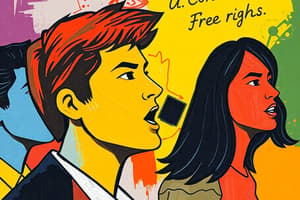Podcast
Questions and Answers
Which case established the precedent for student free speech rights in schools?
Which case established the precedent for student free speech rights in schools?
- Mahanoy vs. Levy
- Tinker vs. Des Moines (correct)
- Brown vs. Board of Education
- Levy vs. School Board
What did the Supreme Court rule in Tinker v. Des Moines (1969)?
What did the Supreme Court rule in Tinker v. Des Moines (1969)?
- Students retain their 1st Amendment rights in public schools. (correct)
- Students can express their views only if they have permission.
- Students have no rights to free speech in school.
- Schools can punish students for any speech.
The 1st Amendment protects students from both public and private repercussions for their speech.
The 1st Amendment protects students from both public and private repercussions for their speech.
False (B)
What are the two conditions under which student speech can be restricted as per the Tinker ruling?
What are the two conditions under which student speech can be restricted as per the Tinker ruling?
In Bethel School District v. Fraser (1986), the Supreme Court ruled that schools can restrict __________ speech.
In Bethel School District v. Fraser (1986), the Supreme Court ruled that schools can restrict __________ speech.
Match the following landmark cases with their key outcomes:
Match the following landmark cases with their key outcomes:
Which case involved a student displaying a banner reading 'Bong Hits 4 Jesus'?
Which case involved a student displaying a banner reading 'Bong Hits 4 Jesus'?
The principal's decision to censor articles in the student newspaper in Hazelwood School District v. Kuhlmeier was upheld as part of __________ speech.
The principal's decision to censor articles in the student newspaper in Hazelwood School District v. Kuhlmeier was upheld as part of __________ speech.
What is the primary reason public schools are considered part of the government?
What is the primary reason public schools are considered part of the government?
The Supreme Court ruling in Tinker v. Des Moines (1969) primarily affirmed which principle regarding students?
The Supreme Court ruling in Tinker v. Des Moines (1969) primarily affirmed which principle regarding students?
What does the Tinker test evaluate regarding student speech in schools?
What does the Tinker test evaluate regarding student speech in schools?
Which Supreme Court case clarified that lewd speech is not protected in schools?
Which Supreme Court case clarified that lewd speech is not protected in schools?
In which context can schools impose restrictions on student speech based on the Tinker ruling?
In which context can schools impose restrictions on student speech based on the Tinker ruling?
What was a significant outcome of the Hazelwood School District v. Kuhlmeier case?
What was a significant outcome of the Hazelwood School District v. Kuhlmeier case?
How does the First Amendment protect students' free speech rights?
How does the First Amendment protect students' free speech rights?
What impact did Morse v. Frederick (2007) have on student speech rights?
What impact did Morse v. Frederick (2007) have on student speech rights?
What was the significance of Mary Beth Tinker's action in school related to free speech?
What was the significance of Mary Beth Tinker's action in school related to free speech?
What was the main reason Brandi Levy was punished by her school?
What was the main reason Brandi Levy was punished by her school?
What significant ruling did the Supreme Court make in the case of Mahanoy Area School District v. B.L.?
What significant ruling did the Supreme Court make in the case of Mahanoy Area School District v. B.L.?
How did the Supreme Court vote on the case of Mahanoy Area School District v. B.L.?
How did the Supreme Court vote on the case of Mahanoy Area School District v. B.L.?
What principle from the Tinker decision was echoed in the ruling for Levy's case?
What principle from the Tinker decision was echoed in the ruling for Levy's case?
Which organization represented Brandi Levy in her case?
Which organization represented Brandi Levy in her case?
What ongoing challenge did the Court acknowledge in its ruling regarding online speech?
What ongoing challenge did the Court acknowledge in its ruling regarding online speech?
Why does the ruling in Levy's case not create a clear line for future cases?
Why does the ruling in Levy's case not create a clear line for future cases?
What is one of the responsibilities schools must balance according to the rulings discussed?
What is one of the responsibilities schools must balance according to the rulings discussed?
How has the legacy of the Tinker decision influenced student engagement?
How has the legacy of the Tinker decision influenced student engagement?
What overarching message does the Levy ruling reinforce about free speech?
What overarching message does the Levy ruling reinforce about free speech?
Flashcards are hidden until you start studying
Study Notes
The First Amendment and Student Speech
- Freedom of speech is the right to express oneself without fear of punishment for what is said.
- The 1st Amendment protects freedom of speech from government intrusion but does not shield from private consequences, such as parental reprimands or social media platforms removing posts.
- Public schools are funded by taxpayers and operated by state and local authorities, making them part of the government, and thus subject to the 1st Amendment.
- The Supreme Court ruled in 1969 in Tinker v. Des Moines Independent Community School District that students retain their 1st Amendment rights in public schools.
- The Tinker ruling established that students can express their views unless it causes "substantial disruption" to the educational process or infringes on the rights of others.
Landmark Cases Defining Student Speech Rights
- Tinker v. Des Moines (1969): Mary Beth Tinker wore a black armband to school to protest the Vietnam War, and was suspended. The Supreme Court ruled that students have a right to symbolic speech in school unless it causes substantial disruption or infringes on the rights of others.
- Bethel School District v. Fraser (1986): A high school student gave a speech at a school assembly using lewd language. The Supreme Court ruled that schools can restrict lewd or obscene speech, creating an exception to the Tinker test.
- Hazelwood School District v. Kuhlmeier (1988): A high school principal censored two controversial articles in the student newspaper. The Supreme Court ruled that schools have broad discretion over the content of school-sponsored publications, establishing a new category of speech "school-sponsored speech."
- Morse v. Frederick (2007): A high school student displayed a banner at a school-sponsored event that read "Bong Hits 4 Jesus." The Supreme Court ruled that schools could restrict speech that promotes illegal drug use, even if it is off-campus.
The Impact of Social Media on Student Speech Rights
- The Tinker test has a significant impact on student speech rights in the context of social media.
- The line between on-campus and off-campus speech becomes blurred with social media, as posts created outside of school can be viewed and shared on campus.
- The Mahanoy Area School District v. B.L. (2021) case raised the question of whether schools can punish students for off-campus speech, especially on social media.
Modern Case: Mahanoy Area School District v. B.L.
- A high school student was suspended from the cheerleading squad after posting a Snapchat story with a vulgar message about the team following not making the varsity cheerleading squad.
- The Supreme Court ruled in Mahanoy that the student's off-campus online speech was protected, but also acknowledged that schools may have a compelling interest in restricting speech that would create a "material disruption" at school.
- The Mahanoy ruling offers some protection for off-campus student speech, but the Court's approach suggests that social media may not always provide the same level of free speech protection as other forms of expression.
Brandi Levy's Case
- Brandi Levy, a high school student, was suspended after posting a vulgar Snapchat message expressing frustration with her cheerleading squad.
- The American Civil Liberties Union (ACLU) represented Levy, arguing that schools should not have authority over off-campus speech.
- The Supreme Court ruled 8-1 in favor of Levy, stating that her off-campus speech didn't cause substantial disruption at school and was therefore protected by the First Amendment.
- The Court emphasized that, while schools have some limitations in punishing off-campus speech, it didn't provide clear rules for all situations, acknowledging the difficulty of creating such rules.
Significance of Tinker Case and Free Speech
- The Court's decision echoes the Tinker vs. Des Moines Independent Community School District case, which established the precedent of student free speech rights in schools.
- The Tinker case, concerning student armbands protesting the Vietnam War, emphasized the importance of free speech development in schools as a critical part of democratic citizenship training.
- The Supreme Court's decision in Levy's case reinforces the notion that young people, even in instances of expressing unpopular or inappropriate opinions, must be allowed space to exchange views.
Implications for Schools and Students
- The Levy ruling highlights the challenges schools face in regulating online behavior and maintaining safe learning environments.
- Schools need tools to address inappropriate student conduct online, particularly in cases of bullying or harassment.
- The Court's ruling encourages student engagement in critical discourse, preparing them to be informed and active citizens.
- Students must continue to exercise their right to free speech, even when facing opposition or societal pressure.
- Free speech is a crucial aspect of civic power that citizens can practice and utilize throughout their lives.
Student Speech Rights
- The First Amendment protects freedom of speech from government intrusion but not from private consequences.
- Public schools are considered part of the government and are subject to the First Amendment.
- Tinker v. Des Moines (1969) established that students retain their First Amendment rights in public schools, unless the speech causes "substantial disruption" or infringes on the rights of others.
- Bethel School District v. Fraser (1986) ruled that schools can restrict lewd or obscene speech, creating an exception to the Tinker test.
- Hazelwood School District v. Kuhlmeier (1988) ruled that schools have broad discretion over the content of school-sponsored publications, establishing a new category of speech "school-sponsored speech."
- Morse v. Frederick (2007) ruled that schools could restrict speech that promotes illegal drug use, even if it's off-campus.
Social Media and Student Speech
- The Tinker test has a significant impact on student speech rights in the context of social media.
- The Mahanoy Area School District v. B.L. (2021) case raised the question of whether schools can punish students for off-campus speech, especially on social media.
Mahanoy Area School District v. B.L.
- A high school student was suspended from the cheerleading squad after posting a vulgar message about the team on Snapchat following not making the varsity cheerleading squad.
- The Supreme Court ruled in Mahanoy that the student's off-campus online speech was protected, but also acknowledged that schools may have a compelling interest in restricting speech that would create a "material disruption" at school.
- The Mahanoy ruling offers some protection for off-campus student speech, but the Court's approach suggests that social media may not always provide the same level of free speech protection as other forms of expression.
Brandi Levy's Case
- Brandi Levy, a high school student, was suspended after posting a vulgar Snapchat message expressing frustration with her cheerleading squad.
- The American Civil Liberties Union (ACLU) represented Levy, arguing that schools should not have authority over off-campus speech.
- The Supreme Court ruled 8-1 in favor of Levy, stating that her off-campus speech didn't cause substantial disruption at school and was therefore protected by the First Amendment.
- The Court emphasized that, while schools have some limitations in punishing off-campus speech, it didn't provide clear rules for all situations, acknowledging the difficulty of creating such rules.
Significance of Tinker and Free Speech
- The Court's decision in Levy's case echoes the Tinker v. Des Moines Independent Community School District case, which established the precedent of student free speech rights in schools.
- The Tinker case, concerning student armbands protesting the Vietnam War, emphasized the importance of free speech development in schools as a critical part of democratic citizenship training.
- The Supreme Court's decision in Levy's case reinforces the notion that young people, even when expressing unpopular or inappropriate opinions, must be allowed space to exchange views.
Implications for Schools and Students
- The Levy ruling highlights the challenges schools face in regulating online behavior and maintaining safe learning environments.
- Schools need tools to address inappropriate student conduct online, particularly in cases of bullying or harassment.
- The Court's ruling encourages student engagement in critical discourse, preparing them to be informed and active citizens.
- Students must continue to exercise their right to free speech, even when facing opposition or societal pressure.
- Free speech is a crucial aspect of civic power that citizens can practice and utilize throughout their lives.
Brandi Levy's Case
- Brandi Levy, a high school student, posted a Snapchat message expressing frustration about her cheerleading experience.
- The school district suspended Levy for her off-campus post, prompting legal action by the ACLU on her behalf.
- The Supreme Court, in a landmark 8-1 decision in 2021, ruled in favor of Levy, affirming her First Amendment right to free speech.
- This was the first time in 50 years that the Supreme Court upheld the free speech rights of a student in a case against a school district.
Key Findings
- The Court established that school officials cannot discipline students for their off-campus speech unless it directly causes a substantial disruption within the school environment.
- Levy's post did not disrupt the school, meaning her speech was protected under the First Amendment.
Implications
- This ruling is notable for its lack of clear guidance on future cases involving off-campus speech.
- While students retain significant protection from punishment for off-campus speech, schools may still be able to impose disciplinary action in instances of online bullying, harassment, or other forms of speech that pose a concrete threat to school safety or function.
- The case underscores the difficulties schools face in managing students' online activity and the need for careful deliberation when addressing off-campus speech.
Connection to Tinker v. Des Moines
- Justice Breyer's opinion, referencing the landmark Tinker v. Des Moines case, emphasized public schools’ crucial role as incubators for democratic participation.
- The Tinker v. Des Moines case, which established a precedent for student free speech, recognized the right of students to express their views despite potential unpopularity or controversy.
The Importance of Free Speech
- The Brandi Levy case underscores the significance of protecting individuals' right to free expression, even when opinions are unpopular or objectionable.
- The First Amendment empowers students to participate in the free exchange of ideas, even when those ideas may be considered inappropriate or mistaken.
- The case illustrates how even seemingly minor issues, like complaints about cheerleading, highlight the fundamental importance of free speech in a democratic society.
- It demonstrates the power of individuals to shape their constitutional rights through active engagement and the need to defend those rights when challenged.
Freedom of Speech in Public Schools
- The First Amendment protects the right to free speech, crucial for a democratic society and revolution.
- Public schools are considered part of the government due to funding and local control.
- Initially, schools held broad control over student speech.
Tinker v. Des Moines
- Mary Beth Tinker wore a black armband protesting the Vietnam War, violating school rules.
- The Supreme Court ruled that students retain First Amendment rights in public schools and that school-imposed restrictions on speech must be justified by a substantial disruption of the school environment.
- The decision emphasized the crucial role of schools in preparing citizens for active participation in a democracy.
The Tinker Test
- Schools can only restrict student speech if it "substantially disrupts" school operations or infringes on other's rights.
- Disruption is understood as meaningful interference with teaching, not mere discomfort or negative comments.
Subsequent Supreme Court Cases
- Bethel School District v. Fraser (1986): Schools can regulate lewd and vulgar speech.
- Hazelwood School District v. Kuhlmeier (1988): Schools have greater control over school-sponsored speech, such as student media.
- Morse v. Frederick (2007): Schools can punish speech promoting illegal drug use.
Mahanoy Area School District v. B.L.
- Brandi Levy, a student, was suspended for a Snapchat post criticizing her cheerleading squad.
- The Supreme Court ruled that schools have limited power to regulate off-campus speech, protecting students' First Amendment rights outside of school.
- The decision acknowledged the challenges of balancing free speech with protecting students and the evolving nature of social media.
Importance of the Levy Ruling
- The Court reaffirmed the principle that students retain First Amendment rights, even on social media.
- Schools must demonstrate a clear connection between off-campus speech and disruption to justify limiting it.
Legacy of Tinker and Levy
- Schools must balance free speech rights with the need for a safe and orderly learning environment.
- Students need to be active citizens, expressing themselves responsibly and effectively.
- The Tinker and Levy decisions show the importance of protecting free speech for all, even when it is controversial or unpopular.
Studying That Suits You
Use AI to generate personalized quizzes and flashcards to suit your learning preferences.




